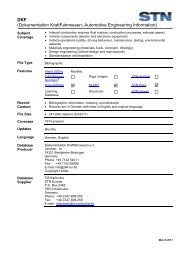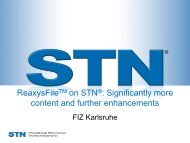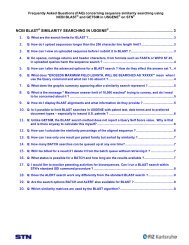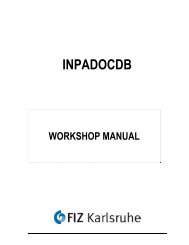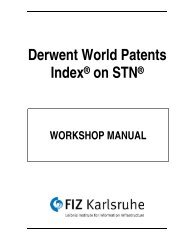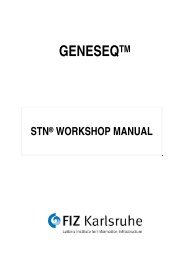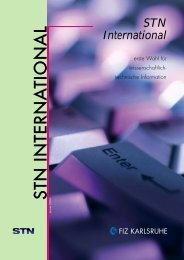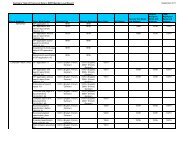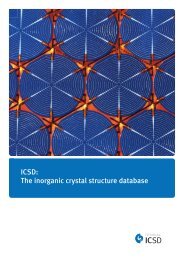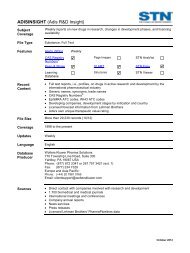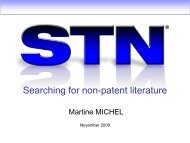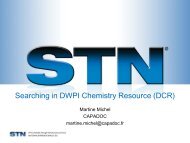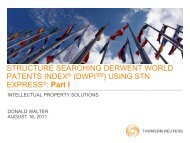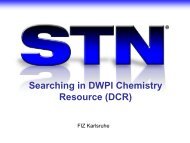Search options available in STN databases - FIZ Karlsruhe
Search options available in STN databases - FIZ Karlsruhe
Search options available in STN databases - FIZ Karlsruhe
You also want an ePaper? Increase the reach of your titles
YUMPU automatically turns print PDFs into web optimized ePapers that Google loves.
19.5.2 Patent assignee<br />
120<br />
Guide to <strong>STN</strong> Patent Databases<br />
A mixed <strong>in</strong>dex with system <strong>in</strong>terpretation is used for Patent Assignees; <strong>in</strong>dividual words from the name therefore<br />
appear <strong>in</strong> one list along with the name ranked as a phrase. Usually a search by s<strong>in</strong>gle words is assumed. (S)<br />
proximity is used automatically:<br />
=> S PROCTER & GAMBLE/PA<br />
11204 PROCTER/PA<br />
11273 GAMBLE/PA<br />
L2 11170 PROCTER & GAMBLE/PA<br />
((PROCTER(S)GAMBLE)/PA)<br />
If the name is to be searched as a phrase it must be entered with quotation marks:<br />
or<br />
=> S "PROCTER & GAMBLE CO"/PA<br />
L3 11059 "PROCTER & GAMBLE CO"/PA<br />
=> S "PROCTER & GAMBLE"?/PA<br />
L4 11169 "PROCTER & GAMBLE"?/PA<br />
The truncation character ? must immediately precede the slash and not be <strong>in</strong>cluded <strong>in</strong> the quotation marks.<br />
If several entries are conta<strong>in</strong>ed <strong>in</strong> the name field every name will be treated as one sentence ((S) proximity). Names<br />
<strong>in</strong> a record are always <strong>in</strong> alphabetical order (may be different from the Patent Gazette).<br />
The complete name (up to 40 letters) is entered for each Patent Assignee. Until Derwent week 9216, a maximum of<br />
24 letters were used.<br />
S<strong>in</strong>ce Derwent week 9216, all Patent Assignees (<strong>in</strong>clud<strong>in</strong>g those of the Equivalents) are added to the PA field. Prior<br />
to this, the number of the patent assignees was limited to 4. Differ<strong>in</strong>g patent assignees of the Equivalents have been<br />
added s<strong>in</strong>ce 1976 (Derwent-Week 7648). The names of Patent Assignees (/PA) are searchable s<strong>in</strong>ce 1970 (year of<br />
<strong>in</strong>troduction <strong>in</strong>to the database).<br />
In addition to the name of the Patent Assignee, a code is entered <strong>in</strong>to the database by the database producer (<strong>in</strong>to<br />
the PACO field). (For the years 1963 to 1969, only this code is <strong>available</strong>.) The code consists of four (three up to 1970)<br />
letters and, where appropriate, a further symbol of identification:-<br />
C for unambiguous codes of major companies (more than 500 documents <strong>in</strong> the database),<br />
I for <strong>in</strong>dividuals act<strong>in</strong>g as assignees,<br />
N for companies which are not part of this group of major companies,<br />
R for <strong>in</strong>stitutions of the former Soviet Union and Russia.<br />
The codes are particularly useful as a search tool <strong>in</strong> the case of the mentioned major companies where they are<br />
unambiguous. The patent assignee code can be searched <strong>in</strong> the /PA field together with the assignee name or<br />
<strong>in</strong>dividually <strong>in</strong> the /PACO field. If an Equivalent carries a different name (e.g. because of a change of the company<br />
name), the new name is entered <strong>in</strong> PA and a new code <strong>in</strong> PACO, where appropriate.<br />
If two companies (hav<strong>in</strong>g standard codes) merge the patents cont<strong>in</strong>ue to be entered under both standard codes as<br />
long as the companies apply for patents as <strong>in</strong>dependent companies. When they change to their new name Derwent<br />
/ Thomson Scientific do not automatically assign a new standard code but the most suitable code is chosen (either a<br />
new code or one of the old codes). The codes <strong>in</strong> exist<strong>in</strong>g documents are not automatically reassigned<br />
retrospectively.<br />
A list of codes (both standard and non-standard) and respective assignee names is <strong>available</strong> on-l<strong>in</strong>e <strong>in</strong> the DWPI<br />
database or on the homepage of Derwent / Thomson Scientific (free of charge):<br />
http://scientific.thomson.com/support/patents/dwpiref/reftools/companycodes/lookup/



